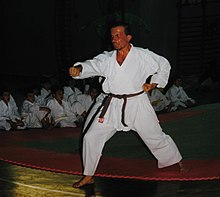Use in martial arts

Students of Japanese martial arts such as aikido, karate, kobudo, kendo or judo (or related arts such as taiko drumming) use kiai to startle an opponent, intimidate, express confidence or express victory.[3] In kendo, for example, a point is only given by the Shinpan (referees) if the hit is accompanied by a strong, convincing kiai. A kiai can also be used besides tightening the core muscles to prevent damage to the stomach. The physical aspects of a kiai are often used to teach a student proper breathing technique when executing an attack which is a common trait adopted by many other foreign martial arts and combat sports. A kiai is also sometimes used to intimidate.[citation needed]
This is especially useful for longer series of attacks such as kirikaeshi, kakari geiko (rapid partner exercise creating openings) and uchikomi geiko (responding fast to openings made by the partner).[citation needed]
Mental imagery techniques are used to teach the martial artist to imagine starting a kiai in the hara or dantian; from a physiological perspective, this means the yell should start in the diaphragm, not the throat.[citation needed]